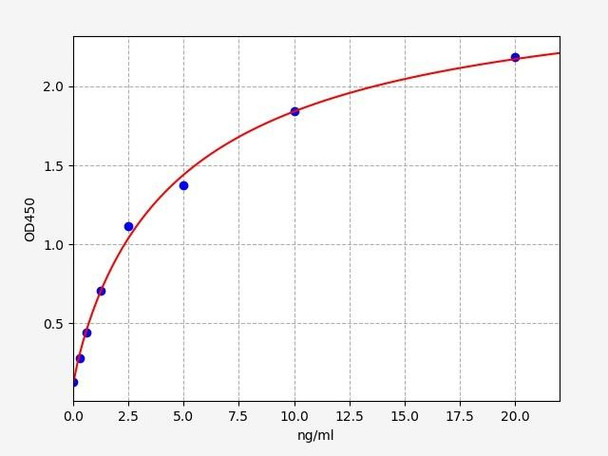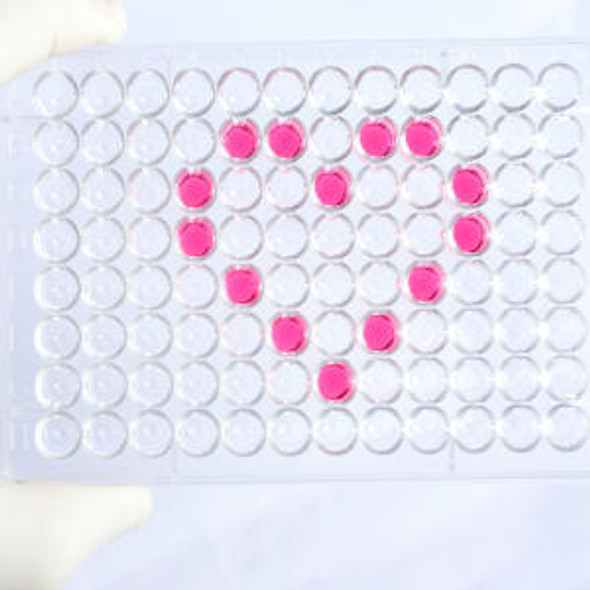Rat BAX ELISA Kit
- SKU:
- RTFI00370
- Product Type:
- ELISA Kit
- Size:
- 96 Assays
- Uniprot:
- Q63690
- Sensitivity:
- 0.188ng/ml
- Range:
- 0.313-20ng/ml
- ELISA Type:
- Sandwich ELISA, Double Antibody
- Synonyms:
- Bax, apoptosis regulator BAX, BCL2-associated X protein, Bcl2-L-4, BCL2L4bcl2-L-4, Bcl-2-like protein 4
- Reactivity:
- Rat
Description
| Product Name: | Rat Bax (Apoptosis regulator BAX) ELISA Kit |
| Product Code: | RTFI00370 |
| Size: | 96 Assays |
| Target: | Rat Bax |
| Alias: | Bax, apoptosis regulator BAX, BCL2-associated X protein, Bcl2-L-4, BCL2L4bcl2-L-4, Bcl-2-like protein 4 |
| Reactivity: | Rat |
| Detection Method: | Sandwich ELISA, Double Antibody |
| Sensitivity: | 0.188ng/ml |
| Range: | 0.313-20ng/ml |
| Storage: | 4°C for 6 months |
| Note: | For Research Use Only |
| Recovery: | Matrices listed below were spiked with certain level of Rat Bax and the recovery rates were calculated by comparing the measured value to the expected amount of Rat Bax in samples. | ||||||||||||||||
| |||||||||||||||||
| Linearity: | The linearity of the kit was assayed by testing samples spiked with appropriate concentration of Rat Bax and their serial dilutions. The results were demonstrated by the percentage of calculated concentration to the expected. | ||||||||||||||||
| |||||||||||||||||
| Intra-Assay: | CV <8% | ||||||||||||||||
| Inter-Assay: | CV <10% |
| Uniprot: | Q63690 |
| UniProt Protein Function: | BAX: Accelerates programmed cell death by binding to, and antagonizing the apoptosis repressor BCL2 or its adenovirus homolog E1B 19k protein. Under stress conditions, undergoes a conformation change that causes translocation to the mitochondrion membrane, leading to the release of cytochrome c that then triggers apoptosis. Promotes activation of CASP3, and thereby apoptosis. Homodimer. Forms higher oligomers under stress conditions. Interacts with BCL2L11. Interaction with BCL2L11 promotes BAX oligomerization and association with mitochondrial membranes, with subsequent release of cytochrome c. Forms heterodimers with BCL2, E1B 19K protein, BCL2L1 isoform Bcl-X(L), BCL2L2, MCL1 and A1. Interacts with SH3GLB1 and HN. Interacts with SFN and YWHAZ; the interaction occurs in the cytoplasm. Under stress conditions, JNK-mediated phosphorylation of SFN and YWHAZ, releases BAX to mitochondria. Isoform Sigma interacts with BCL2A1 and BCL2L1 isoform Bcl-X(L). Interacts with RNF144B, which regulates the ubiquitin-dependent stability of BAX. Interacts with CLU under stress conditions that cause a conformation change leading to BAX oligomerization and association with mitochondria. Does not interact with CLU in unstressed cells. Interacts with FAIM2/LFG2. Interacts with human cytomegalovirus/HHV-5 protein vMIA/UL37. Expressed in a wide variety of tissues. Isoform Psi is found in glial tumors. Isoform Alpha is expressed in spleen, breast, ovary, testis, colon and brain, and at low levels in skin and lung. Isoform Sigma is expressed in spleen, breast, ovary, testis, lung, colon, brain and at low levels in skin. Isoform Alpha and isoform Sigma are expressed in pro- myelocytic leukemia, histiocytic lymphoma, Burkitt's lymphoma, T- cell lymphoma, lymphoblastic leukemia, breast adenocarcinoma, ovary adenocarcinoma, prostate carcinoma, prostate adenocarcinoma, lung carcinoma, epidermoid carcinoma, small cell lung carcinoma and colon adenocarcinoma cell lines. Belongs to the Bcl-2 family. 8 isoforms of the human protein are produced by alternative splicing. |
| UniProt Protein Details: | Protein type:Tumor suppressor; Membrane protein, integral; Apoptosis; Mitochondrial Cellular Component: cytoplasm; cytosol; endoplasmic reticulum; endoplasmic reticulum membrane; integral to membrane; intracellular; membrane; mitochondrial membrane; mitochondrial outer membrane; mitochondrial permeability transition pore complex; mitochondrion; nuclear envelope; nucleus; perinuclear region of cytoplasm; pore complex Molecular Function:BH domain binding; BH3 domain binding; channel activity; chaperone binding; heat shock protein binding; identical protein binding; lipid binding; protein binding; protein complex binding; protein heterodimerization activity; protein homodimerization activity Biological Process: aging; apoptosis; apoptotic mitochondrial changes; B cell apoptosis; B cell homeostasis; B cell homeostatic proliferation; B cell negative selection; blood vessel remodeling; brain development; caspase activation; caspase activation via cytochrome c; cell proliferation; cellular respiration; cerebral cortex development; development of secondary sexual characteristics; DNA damage response, signal transduction resulting in induction of apoptosis; establishment and/or maintenance of transmembrane electrochemical gradient; fertilization; germ cell development; germ cell programmed cell death; glycosphingolipid metabolic process; homeostasis of number of cells; homeostasis of number of cells within a tissue; hypothalamus development; induction of apoptosis via death domain receptors; inner mitochondrial membrane organization and biogenesis; kidney development; leukocyte homeostasis; limb morphogenesis; male gonad development; mitochondrial fragmentation during apoptosis; mitochondrial fusion; myeloid cell homeostasis; negative regulation of cell proliferation; negative regulation of fibroblast proliferation; negative regulation of neuron apoptosis; negative regulation of peptidyl-serine phosphorylation; negative regulation of protein binding; nervous system development; neuron apoptosis; neuron migration; odontogenesis of dentine-containing teeth; outer mitochondrial membrane organization and biogenesis; ovarian follicle development; positive regulation of apoptosis; positive regulation of apoptosis involved in mammary gland involution; positive regulation of B cell apoptosis; positive regulation of neuron apoptosis; positive regulation of pigmentation; positive regulation of protein oligomerization; positive regulation of release of sequestered calcium ion into cytosol; post-embryonic camera-type eye morphogenesis; post-embryonic development; protein homooligomerization; protein insertion into mitochondrial membrane during induction of apoptosis; protein oligomerization; reduction of endoplasmic reticulum calcium ion concentration; regulation of caspase activity; regulation of cell cycle; regulation of mammary gland epithelial cell proliferation; regulation of mitochondrial membrane potential; regulation of neuron apoptosis; regulation of nitrogen utilization; regulation of protein heterodimerization activity; regulation of protein homodimerization activity; release of cytochrome c from mitochondria; release of matrix enzymes from mitochondria; response to axon injury; response to cocaine; response to copper ion; response to corticosterone stimulus; response to DNA damage stimulus; response to drug; response to gamma radiation; response to ionizing radiation; response to salt stress; response to toxin; response to wounding; retina development in camera-type eye; retinal cell programmed cell death; Sertoli cell proliferation; sex differentiation; spermatid differentiation; spermatogenesis; T cell homeostatic proliferation; transformed cell apoptosis; vagina development |
| NCBI Summary: | Bcl2-related gene; involved in the regulation of apoptotic cell death [RGD, Feb 2006] |
| UniProt Code: | Q63690 |
| NCBI GenInfo Identifier: | 2493273 |
| NCBI Gene ID: | 24887 |
| NCBI Accession: | Q63690.2 |
| UniProt Secondary Accession: | Q63690,Q62995, Q64383, |
| UniProt Related Accession: | Q63690 |
| Molecular Weight: | – Da |
| NCBI Full Name: | Apoptosis regulator BAX |
| NCBI Synonym Full Names: | Bcl2-associated X protein |
| NCBI Official Symbol: | Bax |
| NCBI Protein Information: | apoptosis regulator BAX |
| UniProt Protein Name: | Apoptosis regulator BAX |
| Protein Family: | Apoptosis regulator |
| UniProt Gene Name: | Bax |
| UniProt Entry Name: | BAX_RAT |
| Step | Procedure |
| 1. | Set standard, test sample and control (zero) wells on the pre-coated plate respectively, and then, record their positions. It is recommended to measure each standard and sample in duplicate. Wash plate 2 times before adding standard, sample and control (zero) wells! |
| 2. | Aliquot 0.1ml standard solutions into the standard wells. |
| 3. | Add 0.1 ml of Sample / Standard dilution buffer into the control (zero) well. |
| 4. | Add 0.1 ml of properly diluted sample ( Human serum, plasma, tissue homogenates and other biological fluids.) into test sample wells. |
| 5. | Seal the plate with a cover and incubate at 37°C for 90 min. |
| 6. | Remove the cover and discard the plate content, clap the plate on the absorbent filter papers or other absorbent material. Do NOT let the wells completely dry at any time. Wash plate X2. |
| 7. | Add 0.1 ml of Biotin- detection antibody working solution into the above wells (standard, test sample & zero wells). Add the solution at the bottom of each well without touching the side wall. |
| 8. | Seal the plate with a cover and incubate at 37°C for 60 min. |
| 9. | Remove the cover, and wash plate 3 times with Wash buffer. Let wash buffer rest in wells for 1 min between each wash. |
| 10. | Add 0.1 ml of SABC working solution into each well, cover the plate and incubate at 37°C for 30 min. |
| 11. | Remove the cover and wash plate 5 times with Wash buffer, and each time let the wash buffer stay in the wells for 1-2 min. |
| 12. | Add 90 µL of TMB substrate into each well, cover the plate and incubate at 37°C in dark within 10-20 min. (Note: This incubation time is for reference use only, the optimal time should be determined by end user.) And the shades of blue can be seen in the first 3-4 wells (with most concentrated standard solutions), the other wells show no obvious color. |
| 13. | Add 50 µL of Stop solution into each well and mix thoroughly. The color changes into yellow immediately. |
| 14. | Read the O.D. absorbance at 450 nm in a microplate reader immediately after adding the stop solution. |
When carrying out an ELISA assay it is important to prepare your samples in order to achieve the best possible results. Below we have a list of procedures for the preparation of samples for different sample types.
| Sample Type | Protocol |
| Serum: | If using serum separator tubes, allow samples to clot for 30 minutes at room temperature. Centrifuge for 10 minutes at 1,000x g. Collect the serum fraction and assay promptly or aliquot and store the samples at -80°C. Avoid multiple freeze-thaw cycles. If serum separator tubes are not being used, allow samples to clotovernight at 2-8°C. Centrifuge for 10 minutes at 1,000x g. Removeserum and assay promptly or aliquot and store the samples at-80°C. Avoid multiple freeze-thaw cycles. |
| Plasma: | Collect plasma using EDTA or heparin as an anti-coagulant. Centrifuge samples at 4°C for 15 mins at 1000 — g within 30 mins of collection. Collect the plasma fraction and assay promptly or aliquot and store the samples at -80°C. Avoid multiple freeze-thaw cycles.Note: Over haemolysed samples are not suitable for use with this kit. |
| Urine & Cerebrospinal Fluid: | Collect the urine (mid-stream) in a sterile container, centrifuge for 20 mins at 2000-3000 rpm. Remove supernatant and assay immediately. If any precipitation is detected, repeat the centrifugation step. A similar protocol can be used for cerebrospinal fluid. |
| Cell Culture Supernatant: | Collect the cell culture media by pipette, followed by centrifugation at 4°C for 20 mins at 1500 rpm. Collect the clear supernatant and assay immediately. |
| Cell Lysates: | Solubilize cells in lysis buffer and allow to sit on ice for 30 minutes. Centrifuge tubes at 14,000 x g for 5 minutes to remove insoluble material. Aliquot the supernatant into a new tube and discard the remaining whole cell extract. Quantify total protein concentration using a total protein assay. Assay immediately or aliquot and store at ≤ -20°C. |
| Tissue Homogenates: | The preparation of tissue homogenates will vary depending upon tissue type. Rinse tissue with 1X PBS to remove excess blood & homogenizein 20ml of 1X PBS (including protease inhibitors) and store overnight at ≤ -20°C. Two freeze-thaw cycles are required to break the cell membranes. To further disrupt the cell membranes you can sonicate the samples. Centrifuge homogenates for 5 mins at 5000xg. Remove the supernatant and assay immediately or aliquot and store at -20°C or-80°C. |
| Tissue Lysates: | Rinse tissue with PBS, cut into 1-2 mm pieces, and homogenize with a tissue homogenizer in PBS. Add an equal volume of RIPA buffer containing protease inhibitors and lyse tissues at room temperature for 30 minutes with gentle agitation. Centrifuge to remove debris. Quantify total protein concentration using a total protein assay. Assay immediately or aliquot and store at ≤ -20 °C. |
| Breast Milk: | Collect milk samples and centrifuge at 10,000 x g for 60 min at 4°C. Aliquot the supernatant and assay. For long term use, store samples at -80°C. Minimize freeze/thaw cycles. |










